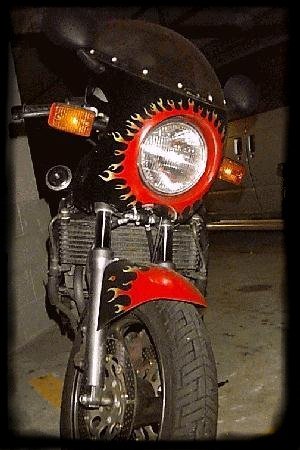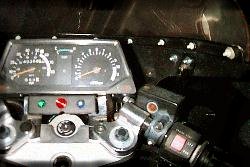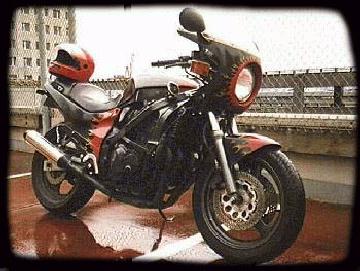When I went to see the bike, it was exactly as described. It was kept indoors, and
showed no signs of distress. It rolled and the engine was free. The only mild surprise
was that the back tire was flat, but the machine had apparently been sitting for
some time. I came back with a truck a few days later and fetched it home.
I was determined to keep this a low-buck project. The 600 Katana, or really any of
the air-oil cooled Katanas, had never been on my list of bikes to have. The Katanas
are almost the VW Beetles of sportbikes, with unique engines, relatively tame performance,
attractive pricing, and no year-by-year restyling. This 1989 was pretty much identical
to the '97 models. I knew that they were nice enough, but they always seemed a little
compromised - not as hard-core as the GSXRs, and the 600 was burdened with a sleeved-down
version of the larger motors. But for $300 I could live with a lot of compromises.
Of course, I realized that $300 would be just the start of the expense of getting
this bike back on the road. One of the disadvantages of modern, faired sportbikes
is the expense of replacing those parts. In the case of the Katana I had to make
a decision whether I wanted to return this machine to its original form, or plan
a different fate for it. The first alternative would be much more expensive, but
the second would make demands on my creativity and time. After some deliberation,
I plotted a middle course. The gas tank offered no easy options. Due to the modern,
perimeter construction of the frame, there was no central frame member running along
the top that could accommodate one of the old-style tanks I had. So I'd definitely
need a stock tank. The rear half of the Katana was littered with numerous parts,
mostly electrical, that did not present a particularly neat or attractive picture,
and there didn't seem to be any easy way to clean it up. The old trick of just ripping
it all out like I had on the old Kawasaki Z-1 wouldn't work here, since I couldn't
go all the way and remove the battery box - this machine was electric-start only.
The easiest solution was to cover those with a pair of stock panels, which were available
out of the JC Whitney catalog for $50 each. JC Whitney also provided the stock front
fender and GSXR-style mirrors, which give me a great view of my arms. The side panels
and fender, it turned out, were made by Maier Racing of California.
But this bike wasn't going to be completely unfaired. I had an old BMW head fairing
that had been laying around ever since about 1981, when I got it on a Ducati 750
that I never did anything with. It apparently had originally come off an R90 from
the '70s, and was in decent shape. Mounting it would require a little engineering,
but, hey, that's part of the reason you take on these projects. Other parts I had
laying around that could be pressed into service were an old headlamp, Yamaha turn
signals and instrument pod, and various pieces of odd-color wire that could be grafted
onto the remnants of the wiring harness. |
The first parts to be actually procured were a battery and ignition switch so I could
fire up the motor to assess the soundness of further investment. The Katana passed
this test to my complete satisfaction, behaving precisely like a machine that hadn't
been run in quite some time. It started with considerable hesitation and at first
refused to run at less than a couple thousand RPM, but got a little better the more
it was run, and in a few minutes had settled down to a half way decent idle. It did
look way weird, though, with the red, black and green peanut tank from my old Sportster
perched atop its cam cover.
With the engine's health now verified, I eliminated any consideration of grafting
the front forks onto my old Z-1 (they probably would have been too short, anyway)
and proceeded with the repair. A salvage yard in San Francisco shipped me a tank,
and the new locking cap came from the local Suzuki dealer. A salvage yard in Tacoma
provided a petcock that, while not
really correct, was a lot cheaper than the $85 or so a new one would have cost. Another
trip to the dealer and a measly $15 outlay produced mini-turn signals (called "marker
lights" for obvious legal reasons) which were pressed into service on the rear
of the machine. |
 |
|
Since the strategy was to complete this project with a minimal outlay of time and
money, the paint job had to be kept simple, The side panels and front fender were
already black, so it made sense to just make this a black motorcycle. Flames would
complement the custom-bike effect I was after, and offset the overwhelming blackness
of the engine, frame, wheels and body
parts.
Painting the flames turned out to be a challenge. Normally I would have painted everything
a light primer and then red, then masked off the red and shot the black to make the
flames. Since the parts were already black,
painting red flames on top would have required a lot of paint to get a reasonable
color. Using many coats would have been a hassle, plus it would have made it just
that much harder to blend the edges of the flames. I decided to paint over the black
with a relatively opaque, light color before applying the red. But I still wasn't
satisfied with the amount of paint it took to cover the black, so I decided to paint
a large area in the light, yellow base I was using for the flames. I then masked
off the shape of the flames and shot the black. Then I coated the unmasked areas
with petroleum jelly, removed the tape, and shot the red onto the exposed flame shapes,
leaving a yellow outline. With a little practice, this technique worked pretty well,
producing decent results considering it was all shot out of aerosol cans.
 |
All the pieces came together fairly well. Getting the fairing mounted properly took
two tries, but in the final analysis the effort to fabricate the required brackets
was not excessive, considering the results versus the cost. The large Yamaha turn
signals were mounted in such a way that they would deflect wind away from the hands,
and this arrangement has yielded appreciable results on chilly morning rides. Less
successful was the adaptation of the Yamaha instruments. The 85 MPH Joan Claybrook
speedometer seems to register a little low, although I would expect the opposite
since the 1982 Vision that it came off of had an 18" front wheel instead to
the 17" unit on the Kat. The stock Katana drive cable just barely reaches the
speedo. I still haven't figured out how to get the electronic tach working, and haven't
yet even made a serious attempt. |
The rear end got the fender-eliminator treatment, of course using home-made brackets.
The front fender mount was made in four pieces from aluminum stock. The horn had
to be relocated to accommodate the fairing. One of the biggest jobs turned out to
be the wiring harness, which required considerable planning due in part to the lack
of detail in the wiring diagram I was using. With the fairing gone, this harness
was exposed in its normal position running along the right frame rail, so after enduring
this eyesore for almost a year I finally pulled the carbs and re-routed the wiring
right up the center of the motor.
Riding the Katana is a pleasure. As a 600, it doesn't have the grunt of some of my
previous machines, but with the revs up, it's about as fast as anything I have owned.
Handling is pretty good, more stable than my 750 Interceptor with its 16 inch front
wheel. After I got the correct tire pressures figured out, handling is just fine
for the type of riding I do, which doesn't involve any serious peg-scraping. But
improvements are in the offing. I have aquired a 750 Katana parts bike that has several
upgrades, the most notable being a GSXR750 motor and front forks, with radial tires
on each end mounted on wider rims. Somehow these parts will be integrated with the
600 Kat to produce, I hope, a much more exciting machine that still retains the practical
features that make this machine such a pleasure to own.  |
Copyright 1998 by Patrick Inniss. All rights reserved.


